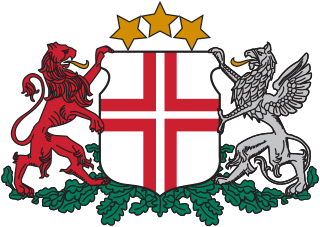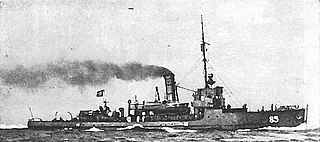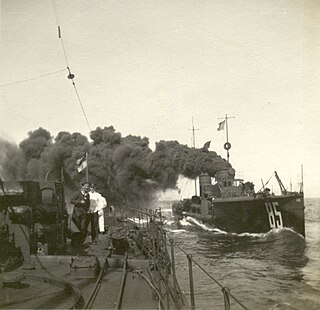
Latvian Naval Forces is the naval warfare branch of the National Armed Forces. It is tasked with conducting military, search and rescue operations, mine and explosive sweeping on the Baltic Sea, as well as ecological monitoring activities. The Naval Forces have participated in international NATO/Partnership for Peace operations and various exercises with great success. The main development priorities of the Naval Forces are to expand their activities within the Baltic States’ Ship Squadron BALTRON and to develop a Sea Surveillance System. They pay a great deal of attention to professionally specialized training and English-language teaching.

ORP Kaszub was a torpedo boat of the Polish Navy, and one of the first ships of that navy after Poland regained its independence in 1918. It was originally built by the German shipyard A.G. Vulcan for the Netherlands Navy as Z4, but was still under construction at the outbreak of the First World War in August 1914, and was seized by the Imperial German Navy, being renamed V108.

HMS Campbell was an Admiralty type flotilla leader of the British Royal Navy. Built by Cammell Laird, Douglas commissioned in December 1918, just after the end of the First World War. During the Second World War, Campbell mainly served with as a convoy escort, particularly on the East Coast of the United Kingdom. She survived the war, and was sold for scrap in 1947.

Z31 was a German Type 1936A (Mob) destroyer, which was completed in 1942 and served with the Kriegsmarine during the Second World War. She was constructed in Germany as part of Plan Z, and commissioned 11 April 1942. She spent much of the war in Arctic and Norwegian waters, taking part in the Battle of the Barents Sea on 31 December 1942. She survived the war, and was passed on to the French Navy as a war prize, serving under the name Marceau until 1958.

SMS G196 was a S-138-class large torpedo boat of the Imperial German Navy. She was built by the Germaniawerft shipyard at Kiel between 1910 and 1911, and was launched on 25 May 1911, entering service later that year. She served throughout the First World War, taking part in the Battle of Heligoland Bight on 28 August 1914. She was renamed T196 in February 1918.

SMS V190 was a S-138-class large torpedo boat of the Imperial German Navy. She was built by the AG Vulcan shipyard at Stettin between 1910 and 1911, completing on 5 August 1911.

Leningrad was the lead ship of her class of six destroyer flotilla leaders built for the Soviet Navy during the 1930s, one of the three Project 1 variants. Completed in 1936, the ship was assigned to the Baltic Fleet and played a minor role in the Winter War against Finland in 1939–1940. After the start of Operation Barbarossa, the German invasion of the Soviet Union in June 1941, Leningrad covered minelaying operations, laid mines herself, and provided naval gunfire support to Soviet units. She escorted ships during the evacuation of Tallinn, Estonia, in August and then bombarded German troops during the Siege of Leningrad. The ship was assigned to evacuate Soviet troops from their enclave in Hanko, Finland, in November, but was badly damaged by mines en route and forced to return to Leningrad for repairs. After they were completed, Leningrad resumed shelling German positions and continued to do so until the Leningrad–Novgorod Offensive drove them away from the city in January 1944.
HMS Talybont was a Type III Hunt-class escort destroyer which served in the Royal Navy. She was launched in February 1943 and completed in May that year, serving for the rest of the Second World War. She took part in the Normandy Landings in June 1944, supporting the landings at Omaha Beach and the Pointe du Hoc. Post war she served in the Mediterranean before being reduced to reserve at the end of 1947. She was sold for scrap in 1961, with disposal completed by 1962.

Smetlivy was one of 29 Gnevny-class destroyers built for the Soviet Navy during the late 1930s. Completed in 1938, she was assigned to the Baltic Fleet and played a minor role in the 1939–1940 Winter War against Finland. After the start of the German invasion of the Soviet Union in June 1941, the ship participated in the Gulf of Riga Campaign before withdrawing to Tallinn, Estonia. Smetlivy supported Soviet forces during the defense of Tallinn in August and covered the subsequent evacuation to Leningrad. The ship provided naval gunfire support to the defenders of Leningrad over the next several months before she was assigned to evacuate Soviet troops from their enclave in Hanko, Finland, in November. Smetlivy struck several mines returning from Hanko and sank with heavy loss of life.
Surovy was one of 18 Storozhevoy-class destroyers built for the Soviet Navy during the late 1930s. Although she began construction as a Project 7 Gnevny-class destroyer, Surovy was completed in 1941 to the modified Project 7U design.

The German minesweeper M18 was a M1935 type minesweeper of the Nazi German Kriegsmarine. Built under the 1937 construction programme by Oderwerke, Stettin, M18 was launched in 1939 and entered service in 1940. She was sunk in an air raid on Kiel on 20 March 1945.

SMS M85 was a M1916 type minesweeper built for the Imperial German Navy during the First World War by the Emden shipyard Nordseewerke, being launched on 10 April 1918 and entering service on 2 October that year. M85 survived the remainder of the war, and was passed on to the Reichsmarine, the navy of the Weimar Republic and then to the Nazi German Kriegsmarine. The outbreak of the Second World War saw M85 supporting the German invasion of Poland in September 1939, and she was sunk by a Polish mine on 1 October 1939 in one of the last acts of the Polish campaign.

Azard was one of eight Orfey-class destroyers built for the Russian Imperial Navy during World War I. Completed in 1916, she served with the Baltic Fleet and joined the Bolshevik Red Fleet after the October Revolution of 1918. She was active during the Russian Civil War, taking part in several engagements against British ships during the British campaign in the Baltic. The destroyer was renamed Zinoviev in 1922 and Artem in 1928. She remained in service with the Soviet Baltic Fleet when Germany invaded the Soviet Union in 1941, and was sunk by a mine on 28 August.
SMS G8 was a V1-class large torpedo boat of the Imperial German Navy. She was built by the Germaniawerft shipyard at Kiel between 1911 and 1912, completing on 6 August 1912.

SMS V185 was a S-138-class large torpedo boat of the Imperial German Navy. She was built by the AG Vulcan shipyard at Stettin in 1910, launching on 9 April that year.
SMS V30 was a V25-class torpedo boat of the Imperial German Navy that served during the First World War. The ship was built by AG Vulcan at Stettin in Prussia, and was completed in November 1914.
SMS S16 was a V1-class torpedo boat of the Imperial German Navy. The ship was built by Schichau-Werke, at their Elbing shipyard, completing in 1912. S16 served with the German High Seas Fleet during the First World War, taking part in the Battle of Jutland in 1916. She was sunk by a mine on 20 January 1918.
The German torpedo boat TA37 was an Ariete-class torpedo boat operated by the German Kriegsmarine during the Second World War. The ship was built for the Italian Navy by the shipbuilder CRDA at their Trieste shipyard with the name Gladio in 1943, but was incomplete when Italy surrendered to the Allies in September 1943, and was seized by Nazi Germany. The ship entered service as TA37 in 1944, serving in the Adriatic and Aegean seas and was sunk by British destroyers on 7 October 1944.
The German torpedo boat TA24 was an Ariete-class torpedo boat operated by the German Kriegsmarine during the Second World War. The ship was built for the Italian Navy by the shipbuilder Ansaldo at their Genoa shipyard with the name Arturo in 1943, but was incomplete when Italy surrendered to the Allies in September 1943, and was seized by Nazi Germany. The ship entered service as TA24 in October 1943, serving in the Tyrrhenian Sea and was sunk by British destroyers on 18 March 1945.
SMS S51 was a torpedo boat of the Imperial German Navy. She was built in 1889–1890 by Schichau at Elbing, as one of a large number of small torpedo boats of similar design built for the German navy. S51 was renamed T51 in 1910, and served as a minesweeper during the First World War, and was mined and sunk in the Baltic on 29 May 1915.













